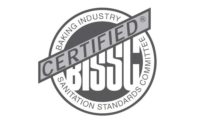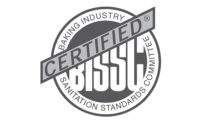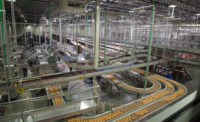In order to do their best to help minimize and prevent issues that can arise in a snack and bakery production environment, suppliers continue to make safety improvements to their equipment. These measures include actively working to streamline safe production and efficient sanitation procedures.
Equipment updates
Eric Riggle, president, Rademaker USA, Inc., Hudson, OH, says that the company has been delivering sanitary washdown equipment to the baking industry for nearly 30 years. While the company makes ongoing improvements to their equipment, some recent updates include:
- Adding “sanitation mode” to the operating system. This development puts the system into a mode to facilitate ease of sanitation, says Riggle. Many of Rademaker’s systems consist of multiple sections. When in sanitation mode, it allows one section of the line to be cleaned while another section is being used for production. This minimizes the downtime required for cleaning and gets clients back into production. Another aspect of the sanitation mode is that items can rotate slowly to allow for cleaning and faster drying. Additionally, conveyor belts can be fitted with belt lifters to keep the conveyor belt off the frame for easier cleaning and faster drying.
- Eliminating recesses, cavities, and dead ends in its equipment design and build that could potentially result in harboring of dirt and contaminants.
- Using sloped surfaces on its machines to facilitate water runoff and minimize collection of debris and dirt.
JLS Automation, York, PA, offers equipment for high-sanitary environments where high-pressure hot water and aggressive cleaning chemicals are in use, says Craig Souser, president and CEO. “This means that our equipment has to be suitable for washdown and, just as important, hygienic design needs to be incorporated to prevent harborage points and to facilitate cleaning. These requirements and design features are now being requested by many of our bakery customers. A direct quote from a large bakery firm’s director of engineering is, ‘We want you to think of us as a cheese plant.’ Food safety and ease of cleaning are driving the bakers to pay far more attention to this than ever,” he says.
Easy, intuitive interaction with the equipment is key to streamlining sanitation procedures. Angela McDaniel, marketing coordinator, Formost Fuji, Woodinville, WA, says that its new Alpha 8 Sanitary wrapper has been designed to be easy to operate, from using the HMI, to disassembling the machine for cleaning and inspection. “Sanitary packaging equipment is no longer just for meat and dairy,” she says. “There has been a lot of progress in the past few years within the bakery and snack industry investing in sanitation for food safety. The Formost Fuji sanitary wrapper offers a quick release, roll away, and complete disassembly option of the infeed conveyor. The Fin Seal and End Seal units can be removed, placed on a cart and rolled away from the wrapper for easy access to the previously inaccessible harbor points in the machine.”
Dimitrios “Jimaco” Pavlidis, production engineer, Van der Graaf (VDG), Shelby Township, MI, says that VDG recently introduced the 3.2-inch-diameter all stainless steel TM80 to its SSV Sanitary Series drum motor. The smaller-diameter drum motor is suited for snack and bakery conveyor applications where the product drop or product transfer from one conveyor to another is limited.
“The new TM80 drum motor, along with the other larger-diameter sizes in the SSV series, are available with continuous profiles to drive modular, wire mesh, and monolithic thermoplastic conveyor belts without requiring sprockets,” says Pavlidis. “The VDG sprocket-less design drum motor eliminates areas for food by-products to accumulate, inhibits bacterial growth, and reduces pressure washdown and sanitization time by up to 50 percent. The SSV Sanitary drum motor has been upgraded to an IP69K rated sealing system, and withstands washdown pressure up to 3,000 psi,” he adds.
Furthermore, in order to keep bacterial count low, the drum temperature of the drum motor had to be substantially reduced, Pavlidis notes. VDG achieved this by redesigning the electric motor to run from 115˚C down to 70˚C nominal operating temperature. The new, cooler running SSV Sanitary drum motor hinders bacterial growth, increasing hygiene.
Newly updated VDG drum motors have a significantly increased service life, Pavlidis says. “The electric motor and gear reducer are designed for 80,000 hours under continuous operation at full load without requiring maintenance. The drum motor with all drive components enclosed inside the drum has a 96 percent mechanical efficiency further decreasing overall operating costs. “
In 2020, VDG will also introduce a new magnetic, gearless (outrunner) drum motor in diameters of 3.2, 4.0, 5.0, 6.5, and 8.5 inches, says Pavlidis. These drum motors will be most suitable for light load conveyor applications due to belt pull and torque limitations.
“The sprocket-less, redesigned, cooler running drum motor combined with the upgraded IP69K sealing system and the addition of the smaller 3.2-inch diameter, makes the new SSV Sanitary Series drum motor design the most sanitary and efficient conveyor drive on the market today,” suggests Pavlidis.
Fundamentally safer
Souser says that JLS Automation has been letting bakery customers know that they have updated various equipment features to improve sanitary design. This includes aspects like sloped surfaces on cabinets, conveyors that pop up easily for cleaning, tools that are easily changed out on the robots for cleaning, and simple mechanical construction to eliminate areas for contamination and make cleaning much easier. The Round Tube design of its frames prevent water or debris from building up. “There are many more design details that contribute to our sanitary offering, but they are either standard in any of our Sanitary Design levels or options that we supply frequently,” he explains.
McDaniel says that the ability to remove major parts of Formost Fuji’s Alpha 8 sanitary wrapper body in order to access all the areas of the machine for sanitation, inspection, and maintenance provides a huge value to the customer. “Labor savings add up when sanitation is made to be simple and user-friendly. Thorough sanitation does not have to be a difficult and dreaded process. We have developed improvements to make this procedure in food safety easy for the wrapper operator and convenient for the sanitation team.”








